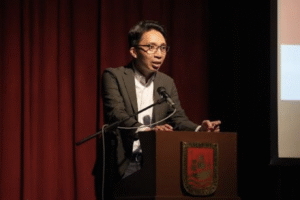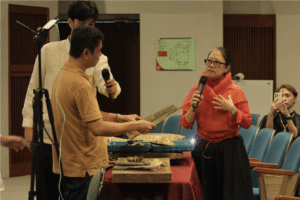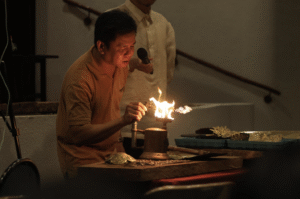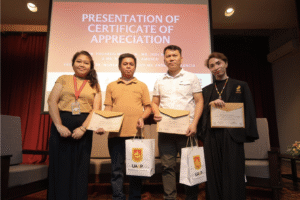By Dr. Moreal Camba, Dr. Dean Mejos, and Ms. Mairene Leynes
College of Arts and Sciences
On the morning of October 15, 2025, the Dizon Auditorium of the University of Asia and the Pacific gleamed with the quiet brilliance of silver, echoing both artistry and devotion. The Arts Department of the College of Arts and Sciences (CAS), in partnership with the National Commission for Culture and the Arts (NCCA), hosted Voices in Silver: Artisan Narratives and the Continuity of the Art of Pinukpuk—a celebration of living heritage and human creativity.
More than an event, it was a meditation on beauty, tradition, and the Filipino spirit—a testament that what is most enduring in art is not merely form or material, but the person who breathes life into them.

Tradition that Breathes, Beauty that Unites
Opening the event, Dr. Dean Mejos, CAS Vice Dean for Faculty Affairs, drew attention to the profound relationship between tradition and beauty, what he called their “dialectical relationship.” He reminded the audience that while tradition is often thought of as something old or rigid, it is in truth something dynamic—alive in the present because people continue to embody it.
“To recognize and honor tradition,” he said, “is to be humble enough to acknowledge that we are part of a story much bigger than ourselves.”
Tradition, Dr. Mejos explained, is not kept alive by mere repetition but by creative interpretation. It is “a dynamic reality which moves us, and moves as we move ourselves.” And when artists like the Mutucs continue their craft, they make visible that movement—the living dialogue between the past and the present.

Quoting Pope Benedict XVI, he added: “This world in which we live needs beauty in order not to sink into despair.” Beauty, like truth, resists time’s erosion. It unites generations and fills the heart with joy. Artists, Dr. Mejos said, are custodians of that beauty—bearers of a gift that strengthens the spirit and restores meaning.
In Voices in Silver, this truth took form. The rhythmic sound of hammer on metal became the voice of tradition itself—steady, prayerful, alive.
The Person as the Heart of Tradition
The morning’s keynote address, delivered by Ms. Mairene Leynes, faculty member of the Department of Arts, unfolded the story of Eduardo Tubig Mutuc Sr., Gawad sa Manlilikha ng Bayan (GAMABA) awardee and master of pinukpuk, the repoussé technique of hammering intricate reliefs from metal.
Born in Apalit, Pampanga, in 1949, Mutuc began life as a farmer with only an elementary education, earning three pesos a day. Out of necessity, he apprenticed as a woodcarver—and in doing so, discovered a calling that would transform his life and the life of a vanishing craft.

“From those modest beginnings,” Leynes shared, “emerged an artist of profound vision—one who would revive a vanishing tradition and embody the enduring unity of beauty and craftsmanship.”
Mutuc’s artistry is a dialogue between maker and material. A plain sheet of brass or silver, under his disciplined hands, becomes a sacred space—cherubim in relief, retablos that shimmer with light and devotion. His art, Ms. Leynes said, is not mere ornamentation but a form of worship.
“This is not mechanical reproduction—it is creation,” she emphasized. “Each strike requires judgment: how much force, at what angle, with what rhythm. The metal remembers every decision.”
Through this sustained dialogue, beauty is not applied to the surface—it is forged in the process, inseparable from the maker. In this way, the person becomes the locus of continuity. The artist’s patience, discipline, and faith give permanence to a fleeting world.
When his son, Eduardo Mutuc Jr., demonstrated pinukpuk before the audience, the meaning of tradition was made visible. Continuity was not an abstract concept—it was the transmission of spirit from father to son, from teacher to learner, from one set of human hands to another.

“Today,” Leynes concluded, “through the hands of Eduardo Mutuc Jr., we witness how such beauty is born—where creativity, discipline, and faith converge to sustain a tradition that continues to give meaning to our shared cultural life.”
Heritage as a Human Calling
As the event came to a close, Dr. Moreal Camba, Chair of the Filipino Department, offered a reflection that drew together the themes of the morning—the artistry, the faith, the humanity that sustains them.
“We gather not merely to admire the artistry of metal,” she began, “but to honor the timeless craft and spirit of the platero—the silversmith and brass-smith whose hands have shaped our cultural memory through generations.”
For Dr. Camba, the pinukpuk art is not merely about hammering metal into form; it is about shaping the self. “It is about patience, precision, and passion—an embodiment of discipline and devotion.”
Each tap of the hammer, she said, echoes the pulse of the people and the rhythm of our forefathers, who knew that “beauty can rise even from the simplest materials.”
“Sa bawat hampas ng martilyo,” she reflected, “may kasamang dasal, may kasamang alaala, at may kasamang pagmamahal sa sining at sa bayan.” In each stroke, there is prayer, memory, and love for art and for country.
Through programs like Gawad sa Manlilikha ng Bayan, Dr. Camba said, we celebrate not only skill but the soul of tradition. The Manlilikha ng Bayan—the bearers of living heritage—teach us that culture is not something preserved behind glass but something practiced in community.
“Hindi man tayong lahat ay may kakayahang magpanday ng pilak,” she said, “pero bawat isa sa atin ay may kakayahang magtaguyod ng kultura—sa pagtangkilik, sa pagtuturo, at sa paggalang sa ating mga ugat bilang Pilipino.”

The Sound of Continuity
As the last echoes of hammer on metal faded, Voices in Silver left behind more than admiration. It left a renewed sense of responsibility—a call to remember that culture endures only through the people who live it.
The art of pinukpuk stands as a radiant metaphor for the Filipino soul: resilient under pressure, refined by patience, and brilliant with faith. It reminds us that the continuity of culture does not rest in objects or institutions alone, but in persons—those who keep beauty alive through their work, their teaching, and their love.
In the shining metal shaped by the Mutucs, we saw ourselves: a people hammered by time, yet never dulled; tested by history, yet still gleaming with grace.
Mabuhay ang mga Manlilikha ng Bayan. Mabuhay ang kulturang Pilipino—matibay, makislap, at patuloy na pinupukpok ng panahon, ngunit kailanman ay hindi kumukupas.#

Photos courtesy of CCO.
Leave a Reply